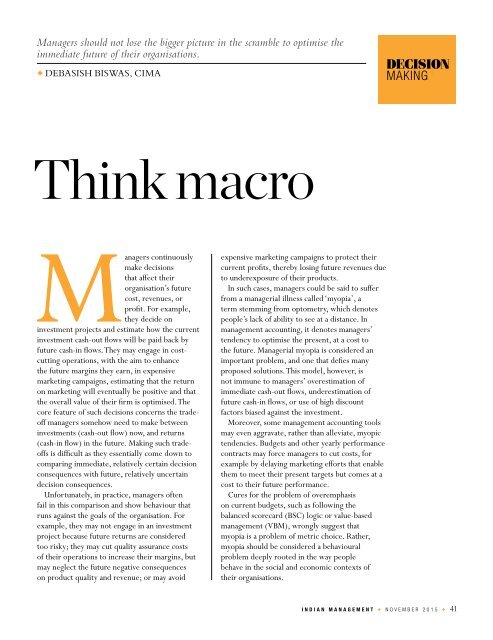the new hr
1NT8tPl
1NT8tPl
You also want an ePaper? Increase the reach of your titles
YUMPU automatically turns print PDFs into web optimized ePapers that Google loves.
Managers should not lose <strong>the</strong> bigger picture in <strong>the</strong> scramble to optimise <strong>the</strong><br />
immediate future of <strong>the</strong>ir organisations.<br />
Debasish Biswas, CIMA<br />
decision<br />
making<br />
Think macro<br />
Managers continuously<br />
make decisions<br />
that affect <strong>the</strong>ir<br />
organisation’s future<br />
cost, revenues, or<br />
profit. For example,<br />
<strong>the</strong>y decide on<br />
investment projects and estimate how <strong>the</strong> current<br />
investment cash-out flows will be paid back by<br />
future cash-in flows. They may engage in costcutting<br />
operations, with <strong>the</strong> aim to enhance<br />
<strong>the</strong> future margins <strong>the</strong>y earn, in expensive<br />
marketing campaigns, estimating that <strong>the</strong> return<br />
on marketing will eventually be positive and that<br />
<strong>the</strong> overall value of <strong>the</strong>ir firm is optimised. The<br />
core feature of such decisions concerns <strong>the</strong> tradeoff<br />
managers somehow need to make between<br />
investments (cash-out flow) now, and returns<br />
(cash-in flow) in <strong>the</strong> future. Making such tradeoffs<br />
is difficult as <strong>the</strong>y essentially come down to<br />
comparing immediate, relatively certain decision<br />
consequences with future, relatively uncertain<br />
decision consequences.<br />
Unfortunately, in practice, managers often<br />
fail in this comparison and show behaviour that<br />
runs against <strong>the</strong> goals of <strong>the</strong> organisation. For<br />
example, <strong>the</strong>y may not engage in an investment<br />
project because future returns are considered<br />
too risky; <strong>the</strong>y may cut quality assurance costs<br />
of <strong>the</strong>ir operations to increase <strong>the</strong>ir margins, but<br />
may neglect <strong>the</strong> future negative consequences<br />
on product quality and revenue; or may avoid<br />
expensive marketing campaigns to protect <strong>the</strong>ir<br />
current profits, <strong>the</strong>reby losing future revenues due<br />
to underexposure of <strong>the</strong>ir products.<br />
In such cases, managers could be said to suffer<br />
from a managerial illness called ‘myopia’, a<br />
term stemming from optometry, which denotes<br />
people’s lack of ability to see at a distance. In<br />
management accounting, it denotes managers’<br />
tendency to optimise <strong>the</strong> present, at a cost to<br />
<strong>the</strong> future. Managerial myopia is considered an<br />
important problem, and one that defies many<br />
proposed solutions. This model, however, is<br />
not immune to managers’ overestimation of<br />
immediate cash-out flows, underestimation of<br />
future cash-in flows, or use of high discount<br />
factors biased against <strong>the</strong> investment.<br />
Moreover, some management accounting tools<br />
may even aggravate, ra<strong>the</strong>r than alleviate, myopic<br />
tendencies. Budgets and o<strong>the</strong>r yearly performance<br />
contracts may force managers to cut costs, for<br />
example by delaying marketing efforts that enable<br />
<strong>the</strong>m to meet <strong>the</strong>ir present targets but comes at a<br />
cost to <strong>the</strong>ir future performance.<br />
Cures for <strong>the</strong> problem of overemphasis<br />
on current budgets, such as following <strong>the</strong><br />
balanced scorecard (BSC) logic or value-based<br />
management (VBM), wrongly suggest that<br />
myopia is a problem of metric choice. Ra<strong>the</strong>r,<br />
myopia should be considered a behavioural<br />
problem deeply rooted in <strong>the</strong> way people<br />
behave in <strong>the</strong> social and economic contexts of<br />
<strong>the</strong>ir organisations.<br />
I NDIAN MANAGEMENT NOVEMBER 2015 41


